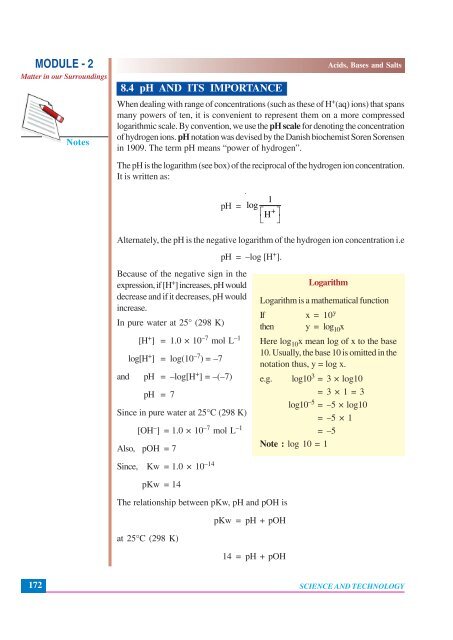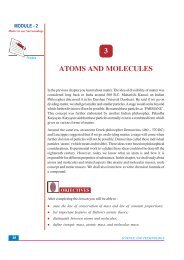8. Acids, Bases and Salts (41.1 MB)
8. Acids, Bases and Salts (41.1 MB)
8. Acids, Bases and Salts (41.1 MB)
Create successful ePaper yourself
Turn your PDF publications into a flip-book with our unique Google optimized e-Paper software.
MODULE - 2<br />
Matter in our Surroundings<br />
Notes<br />
<strong>8.</strong>4 pH AND ITS IMPORTANCE<br />
<strong>Acids</strong>, <strong>Bases</strong> <strong>and</strong> <strong>Salts</strong><br />
When dealing with range of concentrations (such as these of H + (aq) ions) that spans<br />
many powers of ten, it is convenient to represent them on a more compressed<br />
logarithmic scale. By convention, we use the pH scale for denoting the concentration<br />
of hydrogen ions. pH notation was devised by the Danish biochemist Soren Sorensen<br />
in 1909. The term pH means “power of hydrogen”.<br />
The pH is the logarithm (see box) of the reciprocal of the hydrogen ion concentration.<br />
It is written as:<br />
pH =<br />
1<br />
+<br />
log<br />
⎡H<br />
⎣<br />
⎤<br />
⎦<br />
Alternately, the pH is the negative logarithm of the hydrogen ion concentration i.e<br />
pH = –log [H + ].<br />
Because of the negative sign in the<br />
expression, if [H + ] increases, pH would<br />
decrease <strong>and</strong> if it decreases, pH would<br />
increase.<br />
In pure water at 25° (298 K)<br />
[H + ] = 1.0 × 10 –7 mol L –1<br />
log[H + ] = log(10 –7 ) = –7<br />
<strong>and</strong> pH = –log[H + ] = –(–7)<br />
pH = 7<br />
Since in pure water at 25°C (298 K)<br />
[OH – ] = 1.0 × 10 –7 mol L –1<br />
Also, pOH = 7<br />
Logarithm<br />
Logarithm is a mathematical function<br />
If x = 10 y<br />
then y = log 10 x<br />
Here log 10 x mean log of x to the base<br />
10. Usually, the base 10 is omitted in the<br />
notation thus, y = log x.<br />
e.g. log10 3 = 3 × log10<br />
= 3 × 1 = 3<br />
log10 –5 = –5 × log10<br />
= –5 × 1<br />
=–5<br />
Note : log 10 = 1<br />
Since, Kw = 1.0 × 10 –14<br />
pKw = 14<br />
The relationship between pKw, pH <strong>and</strong> pOH is<br />
pKw = pH + pOH<br />
at 25°C (298 K)<br />
14 = pH + pOH<br />
172<br />
SCIENCE AND TECHNOLOGY
















